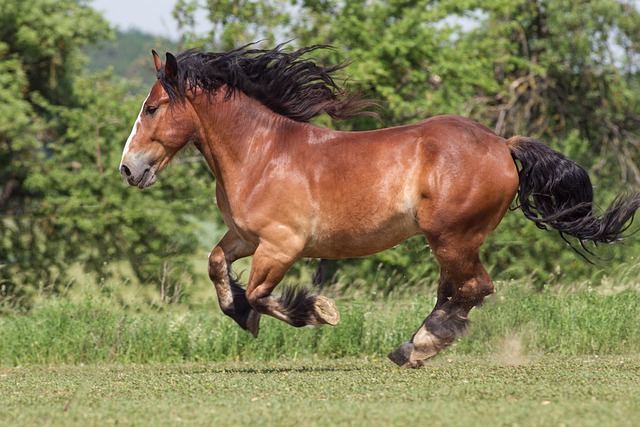Proprioception is a mouthful of a word compared to the other, more commonly understood senses. Sight, hearing, taste, touch, and smell are both simple words and basic sensory concepts that even small kids understand. But what is proprioception, and why is this sense important to horses?
What is Proprioception?
Proprioception is the sense of awareness of the body’s position and movement. It’s how you sense where your legs are relative to your body while walking, or how fast your hand moves when you wave at someone. Proprioception is also called kinesthesia. These broad terms cover our senses of balance, motion, and force.

Image by picardzucht from Pixabay
Both horses and people have a sense of proprioception. Without it, we wouldn’t be able to move around the environment – proprioception is the sense that tells us, without looking, where our body is in relation to things around it. For horses, the sense of proprioception is especially vital during speedy movement. For a wild equine, a poor sense of body position would result in poor coordination and quickly becoming a predator’s meal.
How Proprioception is Perceived
The sense of proprioception comes from receptors all over the body, mostly in the muscles, joints, and skin. When muscles contract and joints flex, receptors signal the brain that motion is taking place. The brain interprets these signals to get an idea of where each body part is, how much effort is being exerted, and how fast the body part is moving. This enables horses to know where their hooves are and how fast they’re moving.
The Importance of Proprioception
Proprioception is an overlooked but important sense. We aren’t consciously aware of it most of the time, but when proprioception is affected, the results can be obvious. Poor coordination can sometimes be a result of problems with proprioception. If a horse or human is less able to perceive the position and movements of their body, of if this information is interpreted incorrectly in the brain, they may be clumsy and more prone to falls or knocking into objects.
The sense of balance is included along with proprioception, and balance is very important to horses both ridden and nonridden. Balance is mostly sensed by special structures in the ear, but receptors in the muscles are very important for providing input about how balanced each part of the body is. The muscles’ ability to tell where they are and how hard they are working is also an important component of balance, because it takes muscles working correctly to hold a horse (or person) in any balanced position.
Proprioception, like some other senses, may become less acute with age. Elderly humans often become less coordinated. While more research is needed on how the perception of the body changes as horses age, elderly horses are usually less agile than younger ones. A slight loss of balance and body coordination may be to blame. Interestingly, proprioception ability can also be reduced by intense exercise – which helps to explain why we sometimes feel a bit clumsy or wobbly after an intense workout. More science is needed to know whether this temporary reduction of proprioceptive ability takes places in equines as well.
In horses with a riding career, proprioception is vital to success. All correct riding requires a lot of skill and coordination from both the horse and the rider, and being able to tell what the body is doing is of huge importance. Proprioception informs the horse how hard or fast they’re going relative to the ground underneath them, how fast they are turning, and how high they’re jumping. It is the sense that enables horses to work around or avoid obstacles, like barrels or jump standards – even when the object isn’t visible. Vision is important for horses both ridden and nonridden, but the sense of body position and coordination is overlooked and probably just as important for successful athleticism.

Image by Markus Spiske from Pixabay
Developing the right sensitivity and response to proprioceptive input is a major part of training and conditioning a high-level riding horse, even if it’s not done intentionally. Exercises that improve muscle use and coordination, like cavaletti or ground poles, also improve the horse’s awareness and perception of their body in relation to the environment.
Enrichment for Proprioception
The best way to provide enrichment for the sense of body awareness and position is to provide a richly textured environment with plenty of structure. The more opportunity your horse has to move through different environments and use its body in different ways, the more proprioception input it receives.
Here are some pasture and stall setup options that promote proprioception as a sensory enrichment:
- Changes in stall substrate – changing from shavings to deep straw, sweeping half the bedding back to create a firm, bare area, etc
- Changes in pasture substrate – adding new topsoil, gravel, or sand; rotating into a new paddock with more or less grass than previously
- Adding proprioception poles to the pasture
- Adding hurdles or stanchions to pasture
- Integrating trees or ground poles into sensory walks
- Offering balance or stretching exercises during training (this requires positive reinforcement sessions in pasture where the horse is free to come and go)
References:
“Proprioception” – Science Direct https://www.sciencedirect.com/topics/neuroscience/proprioception
Proske and Gandevia, 2012. The Proprioceptive Senses: Their Roles in Signaling Body Shape, Body Position and Movement, and Muscle Force. Physiological Reviews. Accessed March 2021 https://journals.physiology.org/doi/full/10.1152/physrev.00048.2011